Menu

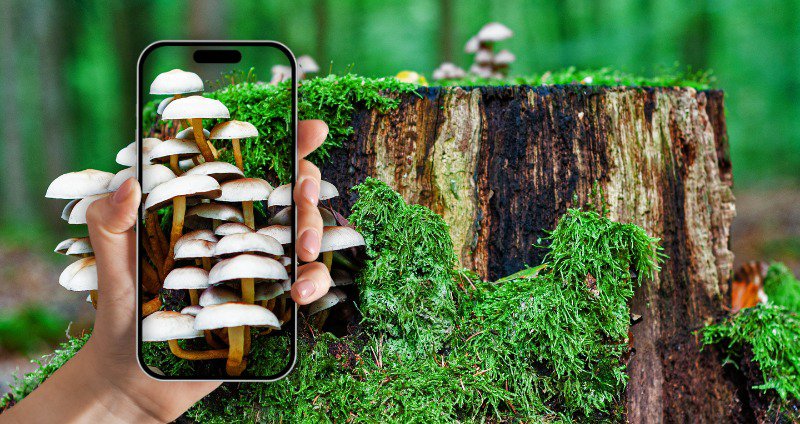
When it comes to identifying mushrooms, choosing the right app is like picking the right seed for your garden.
You want the best seed to keep up with constantly changing environmental conditions and give you the best yield. In the same vein, you want the best mushroom identification app to keep pace with the trends in mushroom foraging and give you accurate results.
In this guide, we’ll review three reliable mushroom identification apps and discuss how their unique features can boost your fungi foraging experience.
The information provided in this article about mushroom identification apps is intended for educational purposes only and does not constitute professional advice. While these apps can be valuable tools for enthusiasts and researchers alike, they should never replace the expertise of a trained mycologist or the guidance of local authorities on foraging.
The natural world is diverse and complex, as many mushroom species are difficult to distinguish. Some mushrooms are highly toxic and can pose serious health risks if misidentified and consumed.
We strongly advise against using these mushroom identification apps as the sole basis for identifying edible or medicinal mushrooms. Always exercise caution, consult multiple sources, and, when in doubt, refrain from picking or consuming wild mushrooms.
Real Mushrooms and the developers of the apps discussed herein accept no responsibility for any harm or injury resulting from the use of these tools or the information contained within this article.
With over a million downloads, Book of Mushrooms has a notable 4.1 rating on Google Play [1].
Certainly among the best mushroom identification apps, right? But it gets better.
This app that provides loads of information on 254 species, including habitats, blooming seasons, edibility, toxicity, and health benefits.
The app contains nifty features, such as:
Zoomed mushroom images of significant resolution capture identifying details to serve as a quick reference for more convenient mushroom identification. These images make it easy to compare your mushrooms with the documented physical attributes of various species.
The photo below, for instance, easily spells out the golden color of the enokitake or velvet shank (Flammulina velutipes) and its distinctive growth pattern, bent near the stem.
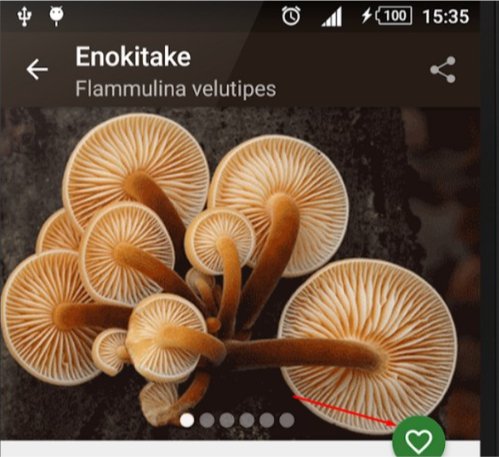
Essential Image Information: The image also displays the mushroom’s natural habitat and woody surroundings. These details act as a checklist for foraging, which must match for the fungi to be identifiable Flammulina velutipes.
The app also includes a like button as a sorting tool for the many species of mushrooms within its image index. See the red arrow in the enokitake image above.
This classification narrows your reference shots to a few favorites to speed up the search-verification process.
It’s one thing to know the physical attributes of a species in order to identify it; it’s another to also understand its blooming seasons. Both aspects work together to clearly identify a species like plot lines in a graph.
With Book of Mushrooms, knowing the blooming seasons of different mushroom varieties adds greater certainty to your identification process. For example, the app includes a note to expect sightings of Velvet Shank mushrooms between September and March of the following year.
Check out the red box below.
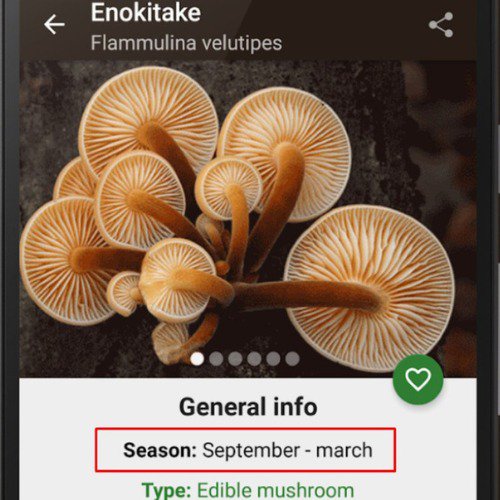
With this information in mind, a fungus that blooms within the months between September and March of the next year must be a Flammulina velutipes,
In case you’re searching for multiple mushroom species simultaneously, the Book of Mushrooms app also features a consolidated calendar of various species to help you work faster.
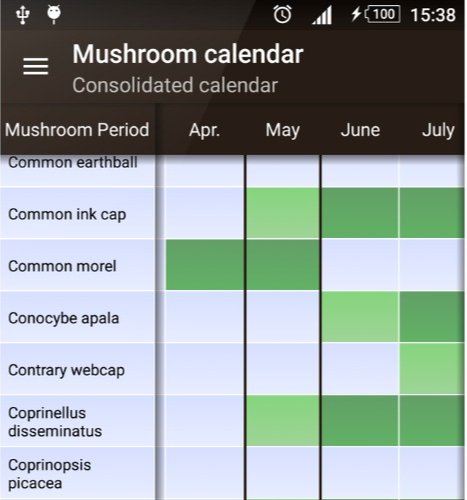
The calendar lists all the mushrooms within the app’s extensive database with adjacent columns noting their blooming months. This lets you monitor different mushrooms and their seasons from one app for a faster and more exciting foraging experience.
Book of Mushrooms features plenty of insightful articles on its 254-species database to get you excited about foraging. The helpful articles explore several mushroom topics, including mushroom health benefits, edibility, and toxicity, with references to scientific publications and statistics for authority.
For example, you’ll discover fascinating facts about mushrooms, such as how early Greeks and Romans were among the first cultivators of the fungi, using them in plenty of must-try dishes for their health benefits.
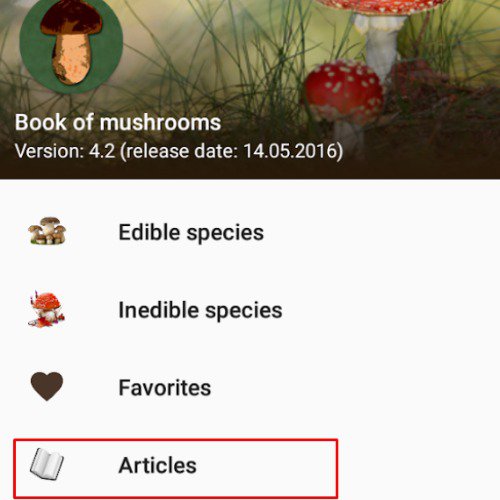
Shroomify is another top-quality mushroom identification app with an exceptionally high 4.7 rating on the App Store and a 4.6 rating on Google Play [3]. These impressive stats are thanks to Shroomify’s convenient features, which are designed to simplify your mushroom hunting experience and make it as fun as possible.
The app’s local search functionality is particularly handy, as it isolates your search to the specific mushroom species currently blooming in your area. Unlike other mushroom identification apps, this geo-targeted blooming calendar helps improve your chances of finding the right fungi.
In the screengrab below, for example, Shroomify highlights the mushrooms found in the Western United States with a note on your likelihood of finding them in May. This accurate mushroom identification strategy helps mushroom enthusiasts focus solely on probable species for May.
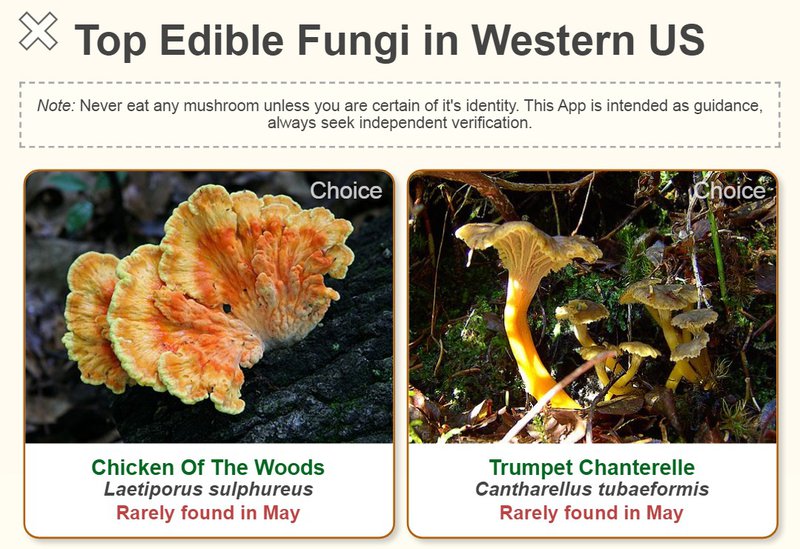
Other interesting Shroomify features include:
Shroomify features a clever algorithm that identifies mushroom species by their physical traits.
Simply input the characteristics of your mushroom find, and Shroomify works out its most likely identity based on the observational data within its comprehensive database. These traits include color, measurements, smell, spore print, and habitat.
In the example below, Shroomify shows results for the Red Cage fungus based on these parameters. You’ll notice that the app includes a frequency chart of recorded sightings within a year to help you identify mushrooms with greater certainty.
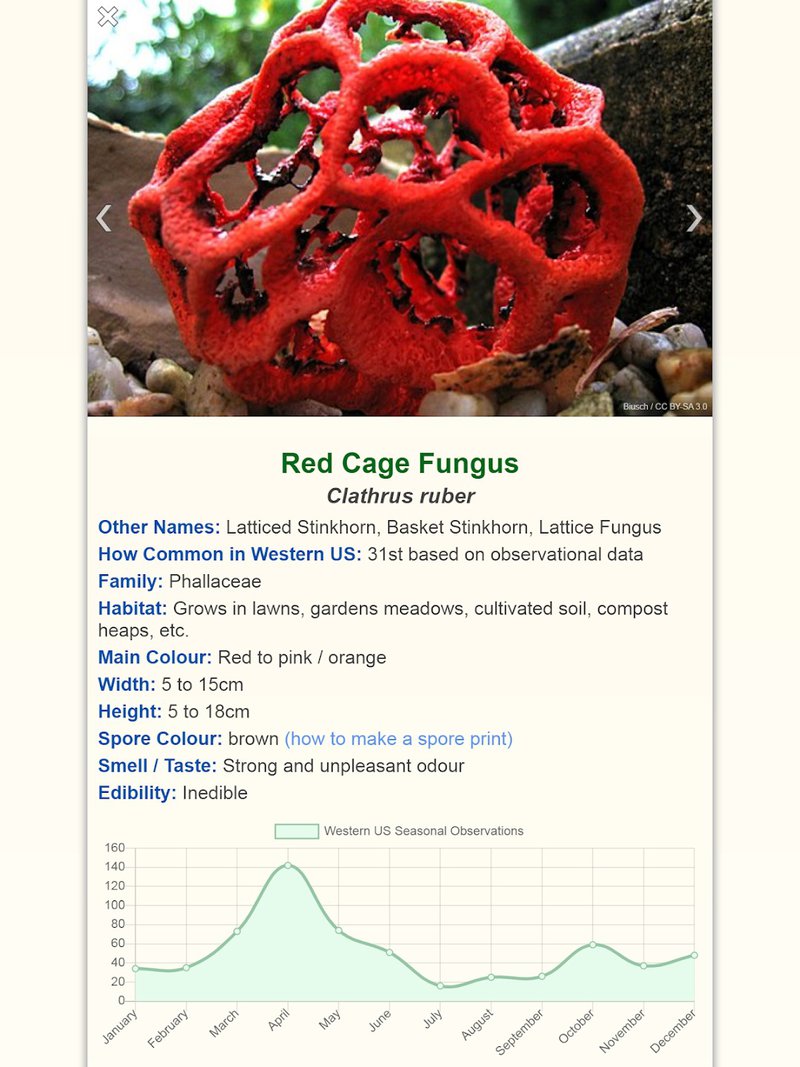
For mushrooms with distinct physical characteristics, a quick visual comparison is enough to objectively identify specific mushrooms. This is where Shroomify boasts its extensive database of HD mushroom images.
The Shroomify app includes over 1000 HD images of 400 mushroom species in its database.
These images capture identifying details such as color, growth patterns, and habitats, which serve as references for your foraging adventure.
In the example below, Shroomify collates images of the poisonous mushrooms you must avoid to stay safe. The shots are in high-definition so that you can notice subtle traits such as color shades.
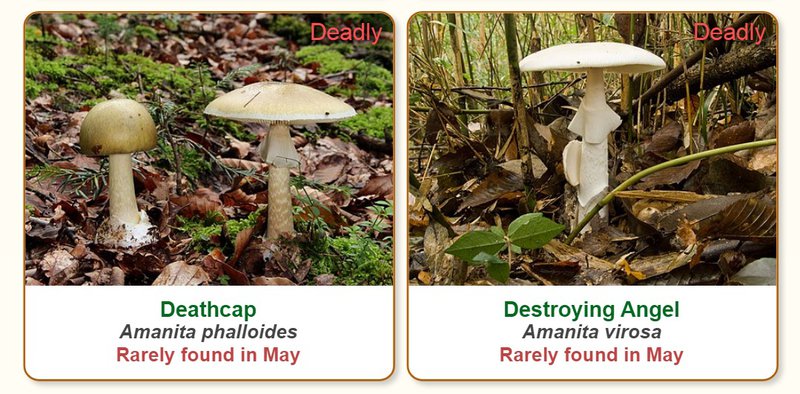
Compare the brilliant white shade on a destroying angel (to the right) with the ivory white of the similarly-shaped deathcap (to the left). Both belong to the poisonous Amanita family of mushrooms and resemble each other but have different toxicity levels.
For example, the deathcap mushroom takes between 8 to 48 hours after ingestion for symptoms to occur while the Destroying Angel takes between 6 to 24 hours before the onset of symptoms.
The Shroomify app has a monthly selection of the top blooming mushroom species in your area to help plan your foraging trip. The monthly selection features a collation of images for easy identification accompanied by notes on key safety aspects of the fungi, such as edibility and toxicity.
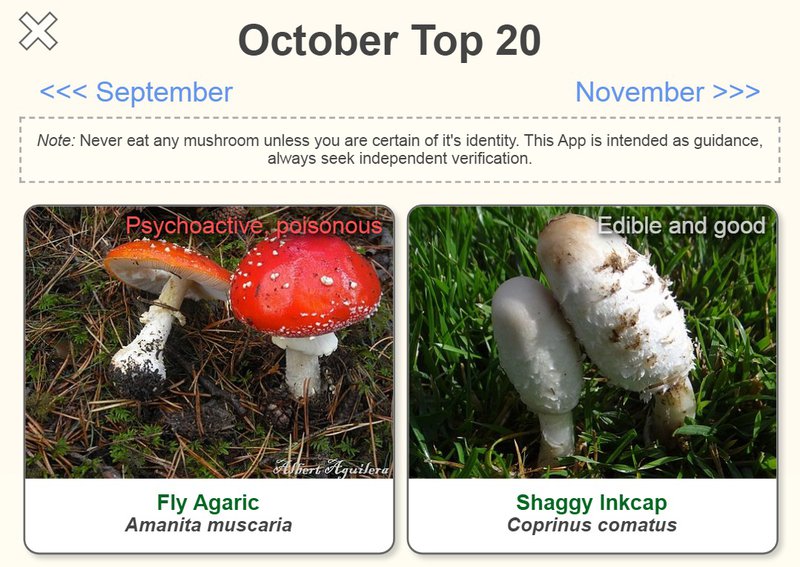
With a commendable 4.7 rating on the App Store and a 4.3 score on Google Play, ShroomID is among the best mushroom identification apps available to keen foragers [2].
The apps offers handy features, including blooming calendars, but its most striking feature is its photo identification function. Simply take a snap of your mushroom and ShroomID will point out the most likely identity of your mushroom sample based on the over 1,000 species in its database.
“ … So much fun identifying mushrooms with this app … As long as my picture has been up to standards, the IDs have been on point.” - Dee, verified ShroomID user, App Store
Other key features of ShroomID include:
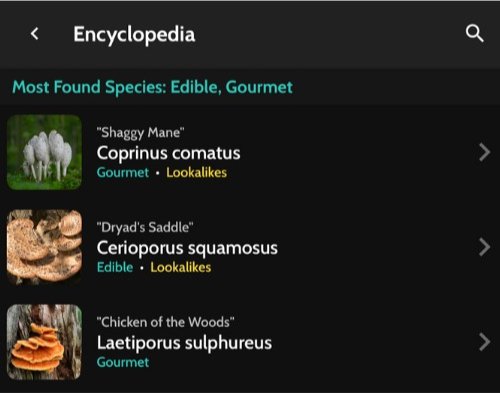
The ShroomID app comes equipped with a mushroom encyclopedia to help you identify mushrooms more effectively. It delves into various mushroom species, looking at key safety features, such as edibility and lookalikes.
Identify Mushrooms With Care: Many edible mushroom species resemble their poisonous counterparts, so it’s crucial that you correctly distinguish between a fungus and its lookalikes.
For example, the poisonous Gyromitra esculenta (False morel), often confused with its lookalike, Morchella (True morel). Both have a honeycomb appearance but a True morel is 100% hollow while a False morel has subtle fibers running through its structure.
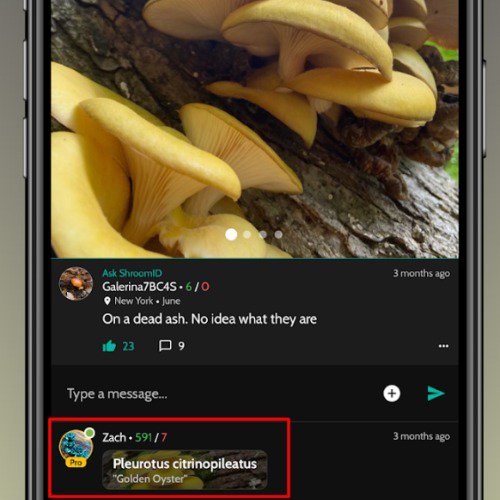
ShroomID also encourages collaboration between mushroom enthusiasts to confirm finds from different users. All you need to do is post a picture of your mushroom to start a conversation about its likely identity, benefits, history, and fun facts.
It's an interesting way of including friends and family in identifying mushrooms in the wild, making it all the more exciting and memorable.
The collaboration feature also improves safety by allowing you to draw from the knowledge and advice of more experienced foragers. For example, certain species of edible mushrooms, such as the Agaricus bisporus become toxic if undercooked.
The following table compares various features of the three mushroom identification apps discussed above.
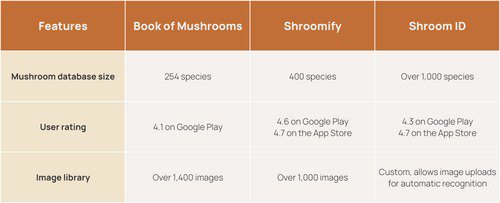
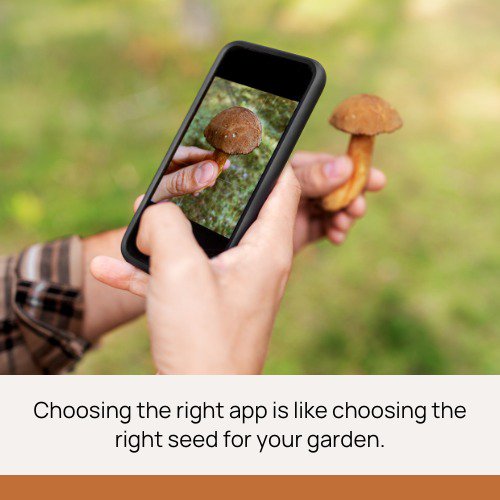
These are just some of the most popular mushroom apps that you can use when going on an adventure to gather wild mushrooms. While the apps have different identification parameters, each app’s distinctive features can help you appreciate the fun of mushroom hunting.
Get Reliable Sources: Keep in mind that the information on these apps should not replace the expertise of a professional mushroom expert. If you plan to use your mushroom finds for cooking or therapeutic use, it may be better to get your mushrooms from a reliable and verified supplier.
So there you have it, the three top mushroom identification apps and their key features. These apps will help you forage in the wilderness and be more familiar with the fungal organisms in your surroundings.
If you’re a fan of using mushrooms for your wellness, you don’t have to wait for your favorite functional mushroom species to grow. Instead, you can order Real Mushrooms supplements all year round.
We pride ourselves on using only 100% organic mushrooms (fruiting bodies) to make our supplements without fillers, mycelium, or additives of any kind. This ensures you receive maximum health benefits from our products for a fair value.
Check out our wide selection of 100% organic mushroom supplements today!
Explore our mushroom FAQs today to learn more about Real Mushrooms and our solutions.
Disclaimer: The information or products mentioned in this article are provided as information resources only, and are not to be used or relied on to diagnose, treat, cure, or prevent any disease. This information does not create any patient-doctor relationship, and should not be used as a substitute for professional diagnosis and treatment. The information is intended for health care professionals only. The statements made in this article have not been evaluated by the Food and Drug Administration. Any products mentioned are not intended to diagnose, treat, cure, or prevent any disease. The information in this article is intended for educational purposes. The information is not intended to replace medical advice offered by licensed medical physicians. Please consult your doctor or health practitioner for any medical advice.